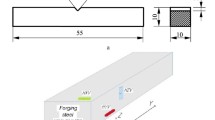Abstract
This paper reports the results of a systematic investigation on the fracture of Charpy-V notch A508 steel specimens, tested in the lower shelf regime. The fracture energy has been determined for quasi-static, standard Charpy and one-point-bend impact. The results show a general trend for the fracture energy to increase with the loading rate, at the lower temperature (∼−160 °C). At this temperature, the roughness of the fracture surface increases markedly with the loading rate. The fractographic analysis shows the presence of 3–4 cleavage initiation sites situated at 100–800 μm from the crack front, irrespective of the loading rate. Numerous cleavage microcracks are observed underneath the main fracture plane. The statistical analysis shows that the length distribution of the microcracks is adequately described by Weibull statistics. It is also found that the number of microcracks increases with the loading rate. It is suggested that the larger number of microcracks is responsible for the observed increased roughness and energy dissipation.
Similar content being viewed by others
References
Aoki, S. and Kimura, T. (1993). Finite element study of the optical method of caustic for measuring impact fracture toughness. Journal of Mechanics and Physics of Solids 41(3), 413–425.
Böhme, W., Kalthoff, JF. (1982). The behavior of notched bend specimens in impact testing. International Journal of Fracture 20, R139–R143.
Böhme, W. (1990). Dynamic key-curves for brittle fracture impact tests and establishment of a transition time. ASTM STP 1074, Judas, G.P. et al. (eds.), pp. 144–156.
Charpy, M.G. (1901). Note sur l'essai des métaux Charpy, M.G., (1901), Note sur l'essai des métaux à la flexion par choc de barreaux entaillés. Mémoires et Compte-rendus de la Société des Ingénieurs Civils de France, June 1901, 848–877.
Denoual, C. and Hild, F. (2000). A damage model for the dynamic fragmentation of brittle solids. Computer methods in applied mechanics and engineering 183, 247–258.
Lautridou, J.C. and Pineau, A. (1981). Crack initiation and stable crack growth resistance in A508 steels in relation to inclusion distribution. Engineering Fracture Mechanics. 15(1-2), 55–71.
Maigre, H. and Rittel D. (1996). Dynamic fracture detection using the force-displacement reciprocity: application to the compact compression specimen. International Journal of Fracture 73(1), 67–79.
Radakovic, Z., Lenkey, G.B., Grabulov, V. and Sedmak, A. (1999). Application of two independent measurement techniques for determination of ductile crack growth initiation. International Journal of Fracture 96, L23–L28.
Ravi-Chandar, K. and Knauss, W.G. (1984). An experimental investigation into dynamic fracture: II. Microstructural aspects. International Journal of Fracture 26, 65–80.
Ravi Chandar, K. and Yang, B. (1997). On the role of microcracks in the dynamic fracture of brittle materials. Journal of Mechanics and Physics of Solids 45(4), 535–563.
Rittel, D. (1998). The influence of temperature on dynamic failure mode transitions. Mechanics of Materials 30(3), 217–227.
Rittel, D. and Maigre, H. (1996). An investigation of dynamic crack initiation in PMMA. Mechanics of Materials 28, 229–239.
Rittel, D., Pineau, A., Clisson, J. and Rota, L. (2002). On testing of Charpy specimens using the one point bend impact technique. Experimental Mechanics (in press).
Rosakis, A.J. and Ravichandran, G. (2000). Dynamic failure mechanics. International Journal of Solids and Structures 37, 331–348.
Ruiz, C. and Mines, R.A.W. (1985). The Hopkinson pressure bar: an alternative to the instrumented pendulum for Charpy tests. International Journal of Fracture 29, 101–109.
Server, W. (1985). Charpy Impact Testing. In ASM Metals Handbook, Vol. 8, ASM, Metals Park, OH.
Sharon, E. and Fineberg, J. (1998). Universal features of the microbranching instability in dynamic fracture. Philosophical Magazine B 78(2), 243–251.
Tanguy, B. Piques, R., Laiarinandrasana, L. and Pineau, A. (2000). Notch stress strain distribution in Charpy V specimen /experiments and modeling. Proceedings ECF 13, FractureMechanics: Applications and Challenges. Elsevier Science.
Author information
Authors and Affiliations
Rights and permissions
About this article
Cite this article
Rittel, D., Tanguy, B., Pineau, A. et al. Impact fracture of a ferritic steel in the lower shelf regime. International Journal of Fracture 117, 101–112 (2002). https://doi.org/10.1023/A:1020917021181
Issue Date:
DOI: https://doi.org/10.1023/A:1020917021181




